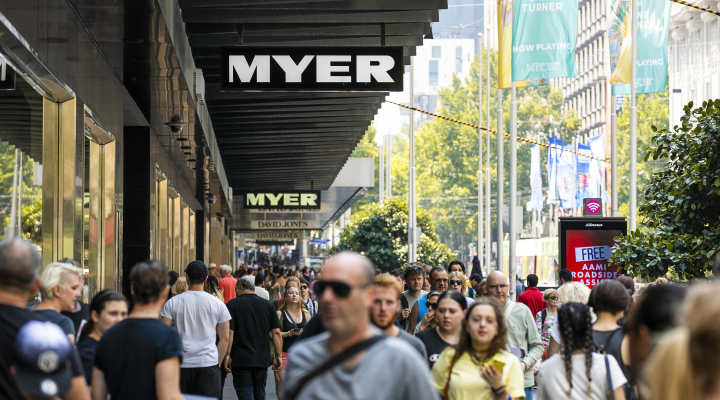Australia’s department stores are at a crossroads. Once the go-to for everything from fashion to homewares, they’re now struggling to stay relevant in a world of online shopping, specialty retailers, and shifting consumer habits. Competition has never been more fierce and while data from the Australian Bureau of Statistics showed an uptick in department-store sales in November, this is likely temporary with earlier months showing stagnation or decline. In September 2024, department-sto
store sales fell by 0.5 per cent, reflecting ongoing challenges in the sector.
So how did we get here? And what lessons can retailers take from the history of the sector to ensure department stores don’t become a relic of the past?
The early days of e-commerce and the globalisation of retail
Many will remember the moment when e-commerce truly began to take off in Australia.
Initially led by eBay, Australian consumers were suddenly empowered to shop beyond their local retail stores. Borders dissolved as we gained access to global brands with just a few clicks, often bypassing Australian retailers altogether.
For fashion brands, this was a liberating time, as they could reach consumers directly, no longer relying on middlemen or bound by geographic constraints. However, department stores like Myer and David Jones found themselves struggling to respond to this shift. While department stores had long been a staple of Australian shopping culture, their ability to adapt to the new reality of retail was a point of concern.
One of the early, bold responses to this challenge came from Myer, under the leadership of Bernie Brookes, who introduced the experimental myfind.com. This offshore-based platform allowed Australians to purchase international goods, circumventing the 10 per cent GST on products under $1000. It was a controversial move, sparking a national debate on the fairness of offshore retailers gaining an advantage over Australian businesses.
While this may have temporarily relieved some pressure, it was clear that department stores were facing an existential crisis. The shopping experience had become far less linear.
Consumers were now free to shop from anywhere, at any time, for any product. For many, the idea of visiting a department store to see a limited selection of brands felt increasingly obsolete, especially when international options were just a click away, with the added bonus of avoiding GST.
A decade and a half later, globalisation of the retail shopping experience has only increased. But that’s not the only challenge with which prestige department stores must contend.
The rise of discount department stores
Discount department stores like Kmart, BIG W and Target have come to dominate the Australian retail landscape with their high-volume, low-cost offerings in homewares, fashion and more. The lines between premium and budget retail have blurred, with discount stores offering everything from fashion to homewares at prices that make it hard for department stores to compete.
As fashion trends have become increasingly fast-paced and disposable, consumers have also turned to these more affordable and accessible retailers.
The situation became even more complicated as department stores tried to position themselves as multi-brand houses but struggled to offer the same agility and pricing power as their budget competitors.
The department store as a house of brands
For department stores, exclusive brand partnerships are key. Offering a point of difference by bringing in brands that cannot be found anywhere else can be a powerful tool to build customer loyalty.
However, this strategy has its pitfalls. The challenge lies in ensuring that these brands maintain their unique identities, as we saw with Sass & Bide. Myer’s attempt to integrate this once-popular brand into its department store structure ultimately led to its decline.
By diluting the brand’s distinctive identity, Myer lost touch with the very customers who had made it a success. The brand was eventually forced to close multiple stand-alone stores, and its presence within Myer was diluted. The lesson here is clear: Gor department stores to succeed, they need to carefully preserve and grow the individuality of the brands they bring in.
What comes next?
The road ahead for Australian department stores is undoubtedly challenging. While the competition from online retailers and discount department stores continues to intensify, there is still potential for department stores to thrive, provided they adapt.
The key to success lies in offering a hybrid model that balances the convenience and reach of e-commerce with the tactile, experiential nature of physical retail.
As more and more consumers turn to online shopping, particularly during high-volume periods like Black Friday and Cyber Monday, department stores must rethink their approach.
Building strong e-commerce platforms and encouraging customers to engage both online and in-store will be essential for success. Brands with solid e-commerce capabilities could hold the key to converting online shoppers into loyal, in-store customers.
At the same time, department store brands must remember that shopping experiences matter. People don’t visit them just for the products anymore; they visit for experiences, for discovery, and for brands that resonate with them.
By fostering those experiences – through partnerships with the right brands, unique offerings, and by creating a sense of identity in-store – Australian department stores can remain a relevant and compelling part of the retail ecosystem.
In the end, it’s about evolving with the times, while still embracing what made department stores great in the first place: the ability to offer choice, convenience, and a curated shopping experience that feels both personal and unique.

